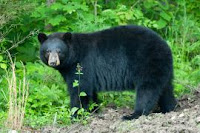Seeing a black bear is Missouri is still an exciting event to most of us. These encounters are occurring more frequently each year as the bear population is expanding north of Arkansas. Rural and forested areas are increasingly subdivided into smaller residential plots. A female black bear's normal range is 1 to 15 miles, while a male will cover 8 to 60 miles, looking for food and love. As this range is increasingly broken up by human habitation, human-bear encounters are inevitable.
This week the first attack of a bear on a human was recorded in Kentucky. Western states have lots of precautions including training for hikers and bear-proof trash and food containers, and we will be seeing more of these in Missouri.
The story of their resurgence is covered in The Bear Truth. I use the term "resurgence" because bears were once very common in Missouri. Henry Rowe Schoolcraft described frequent bear encounters and commercial hunting of bears regularly in the Journal of his trip through Southern Missouri in 1818.
MDC Online has a good resource called Controlling Nuisance Bears, and Conservation magazine has had several good articles this year including the May issue with Be Bearwise in Missouri.
Any wild animal can become used to human presence. The normally shy coyote is no exception. Last week a coyote attacked young girls on two separate occasions in suburban Rye, New York. (New York Times)
The April 29th blog, Turkeys Gone Wild, discussed turkey gobbler attacks on humans. With the peak year our rabbits are having, I expect any day to be surrounded by bunnies nibbling at my boots. As we expand our living space into nature, altering habitat and fragmenting animals range, we prove that the old saying is true. Familiarity does breed contempt.
There is a lot more information on black bears at Americanbear.org.
